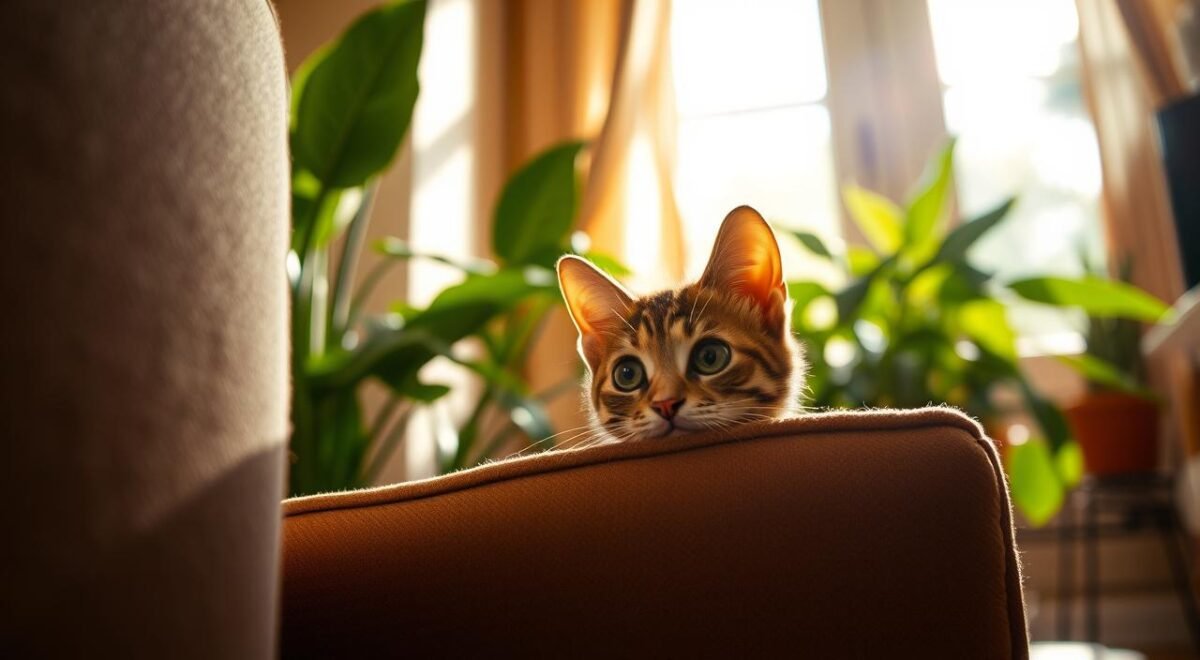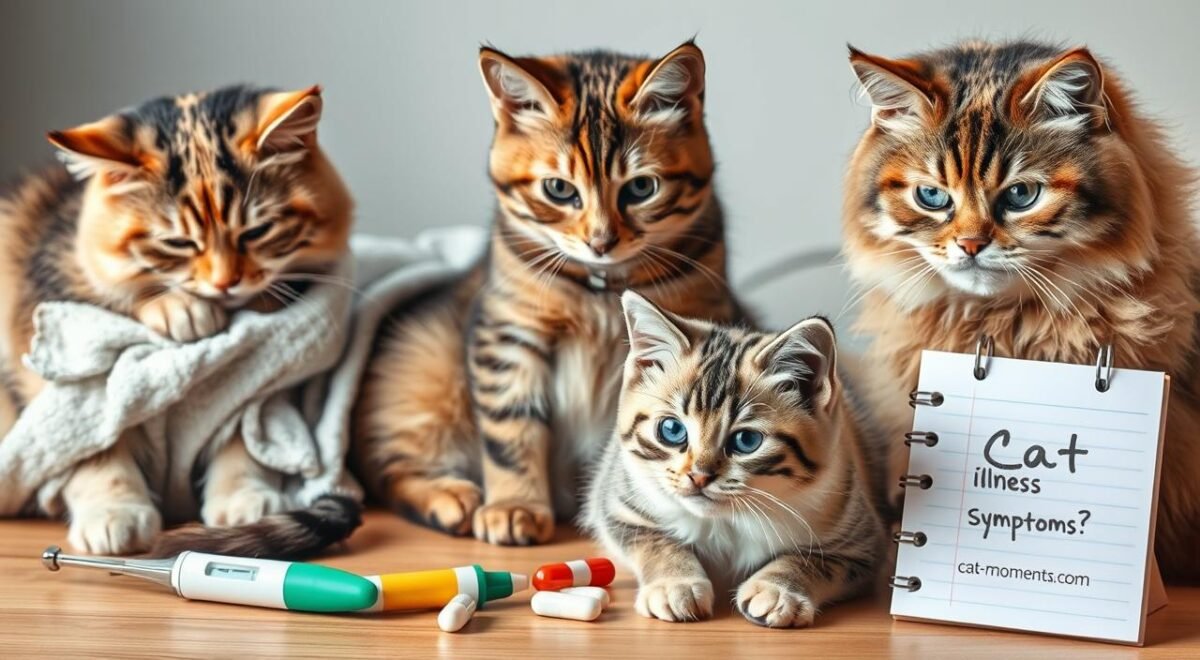Cats are often seen as easy pets, but they can hide health problems. It’s important to take them to the vet regularly. This guide helps you spot illness signs and know when to go to the vet. Catching health issues early is key to treating them well and keeping your cat healthy.
Key Takeaways
- Cats can hide up to 50% of their illness symptoms, highlighting the importance of regular veterinary visits
- Changes in appetite, weight, behavior, and litter box habits can signal underlying health issues
- Recognizing early warning signs, such as respiratory distress or excessive vomiting, is crucial for prompt treatment
- Monitoring a cat’s physical and behavioral changes is key to identifying potential health problems
- Seeking veterinary care at the first sign of illness can help catch and manage health conditions effectively
Understanding Cat Illness Symptoms Guide: Why Cats Hide Their Pain
Cats hide signs of pain and illness to survive, a trait from their wild ancestors. This makes it hard for owners to spot health problems early. It’s key to know the signs of cat disease and sick cat behavior to get them the care they need.
Natural Instincts and Survival Behavior
In the wild, cats hide weakness to avoid being seen as prey. This instinct stays with domesticated cats, making them hide sickness or pain.
The Importance of Early Detection
Cats have been domesticated for about 9,000 years, while dogs have been with humans for 20-40,000 years. Dogs have learned to show illness more clearly, making it easier to notice. Cats, however, are experts at hiding pain, making it harder for owners to spot health issues early.
Common Misconceptions About Cat Health
Many think cats are easy to care for and don’t get sick often. But cats are great at hiding pain and discomfort. They show small changes in behavior that can be missed or misunderstood. It’s important to understand these signs to get them the care they need quickly.

“Cats have been on the journey to domestication roughly 9,000 years ago, while the domestication of dogs began 20-40,000 years ago. This longer period of coevolution has allowed dogs to develop more overt communication with their human companions, making it easier to recognize signs of illness.”
Researchers at the University of Montreal created the Feline Grimace Scale. It helps spot pain in cats by looking at ear, eye, muzzle, head, and whisker positions. Vets like Dr. Lacie at Cat Care Center use this scale to watch for signs of discomfort in sick cats.
Critical Behavioral Changes That Signal Illness
Watching your cat’s behavior is key to spotting health issues early. Changes in behavior can be the first sign of illness. Look out for signs like aggression, too much meowing, or hiding.
Changes in grooming habits are also important. If your cat is grooming less or more than usual, it could mean they’re not feeling well.
Cats may act restless or have trouble sleeping when sick. They might also hide more. It’s important to notice these changes early. This is because cats often hide their symptoms to seem strong.
“Early detection of illness in cats is crucial as they often conceal their symptoms to avoid appearing weak or vulnerable to predators.”
By paying attention to your cat’s usual behavior, you can catch health problems early. This is a big part of keeping your cat healthy and happy. It helps follow their cat wellness manual and cat symptom handbook.

Keeping an eye on your cat’s behavior and acting fast can greatly improve their life. Being a careful observer and advocate for your cat is crucial. It helps protect their health and happiness.
Physical Warning Signs and Body Changes
As pet owners, it’s key to notice when our cats might be sick. By spotting these signs early, we can help them feel better sooner. This way, we make sure our cats stay healthy and happy.
Changes in Eating and Drinking Patterns
When a cat’s eating or drinking habits change, it might mean they’re not feeling well. If they stop eating or drink more water than usual, it could be a sign of illness. This could be anything from a simple tummy ache to something more serious like diabetes.
Weight Fluctuations and Body Condition
Changes in a cat’s weight can tell us a lot about their health. Losing weight might mean they’re not eating right or have a serious illness. On the other hand, gaining weight could be a sign of too many treats or even a tumor.
A cat’s coat can also give us clues about their health. If it looks dull or matted, it might mean they’re not feeling their best.
Visible Physical Symptoms
Some health issues are easy to spot. For example, if a cat is breathing hard or limping, it could be a sign of trouble. Even things like eye or ear discharge or seizures can mean they’re not well.
By watching our cats closely, we can catch health problems early. This helps them get the care they need and live a long, happy life.
“Paying close attention to our cats’ physical cues and changes can help us catch health issues early, ultimately leading to better outcomes and a higher quality of life for our furry friends.”
Emergency Symptoms Requiring Immediate Veterinary Care
Some cat illness symptoms need quick vet attention. Knowing these cat disease signs and kitty sickness indicators can save your pet’s life.
Signs like trouble breathing, constant vomiting or diarrhea, and severe pain are emergencies. Also, sudden collapse, seizures, or lasting tiredness are critical. Male cats straining to pee can have a serious urinary blockage that needs fast help.
Seeing a lot of blood, accidents, or eating something toxic are also urgent. Quick action to these cat illness symptoms can save a cat’s life.
| Emergency Symptom | Potential Underlying Issue |
|---|---|
| Difficulty Breathing | Respiratory distress, lung or heart disease |
| Persistent Vomiting or Diarrhea | Gastrointestinal infection, obstruction, or poisoning |
| Straining to Urinate | Urinary tract blockage, potentially life-threatening |
| Severe Bleeding | Trauma, internal bleeding, or clotting disorder |
| Seizures | Neurological conditions, toxin exposure, or trauma |
Watching for these cat illness symptoms and getting vet help fast is crucial. It helps your cat get the best care and avoid serious problems or even death.
Conclusion
Knowing the signs of cat illnesses is key for pet owners. Regular vet visits and watching for changes in your cat’s behavior and health are important. Early treatment can greatly improve your cat’s life.
Being aware and watching closely can help your cat get the care they need. Look out for changes in eating, weight, or litter box use. This proactive approach can catch health issues early.
Having a cat wellness guide and knowing the signs of illness is crucial. By focusing on your cat’s health and getting vet care when needed, you can give them the best life. This ensures your pet stays happy and healthy.
FAQ
What are the common signs of illness in cats?
Cats may show signs of illness like acting differently, meowing more, or hiding. They might also groom less or more than usual. These changes can mean they’re not feeling well.
Why do cats hide their pain and illness?
Cats hide their pain and illness because it’s a survival trait from their wild days. This makes it hard for us to notice they’re sick early on.
How can I recognize behavioral changes that indicate a health problem?
Look for signs like restlessness, trouble sleeping, or hiding more. These changes can mean your cat is not feeling well. Keeping an eye on these signs is key to catching health problems early.
What physical symptoms should I look for in my cat?
Watch for changes in how your cat eats, drinks, or their weight. Also, look for a dirty coat, limping, or breathing issues. Changes in how they go to the bathroom are another sign.
When should I seek immediate veterinary care for my cat?
Call the vet right away if your cat has trouble breathing, keeps vomiting, or shows a lot of pain. Also, seek help if they collapse, have seizures, or can’t get up. Other urgent signs include bleeding a lot, straining to pee, or acting really sick after an accident or eating something bad.
Source Links
- https://www.capitalhomevetcare.com/blog/6-signs-your-cat-needs-to-see-a-vet-immediately/
- https://urgentvet.com/sick-cat-symptoms-signs-of-illness/
- https://marinavillagevet.com/how-to-tell-if-your-cat-is-sick/
- https://heartandpaw.com/pet-parent-resources/cat-hiding
- https://www.catcarecenter.com/services/cats/blog/understanding-and-recognizing-pain-felines
- https://www.ctvsh.com/services/cats/blog/secret-behind-why-cats-hide-pain-and-what-you-need-know
- https://victoriaroadvet.com/signs-of-sickness-in-cats/
- https://dixieroadpet.com/signs-of-illness-in-cats/
- https://www.petmd.com/cat/general-health/how-tell-when-cat-sick
- https://www.thesprucepets.com/signs-your-cat-is-sick-4165142
- https://www.embracepetinsurance.com/waterbowl/article/how-to-tell-if-your-cat-is-sick
- https://anicira.org/resources/10-signs-your-cat-is-having-a-veterinary-emergency/
- https://vcahospitals.com/know-your-pet/emergencies-in-cats
- https://insightvetwellness.com/blog/pet-owners-learn-how-to-identify-a-true-health-emergency-and-when-to-seek-emergency-veterinary-care/
- https://www.catster.com/cat-health-care/how-to-tell-if-cat-is-sick/
- https://blakehurstvet.com.au/how-to-recognise-illness-in-your-cat/






